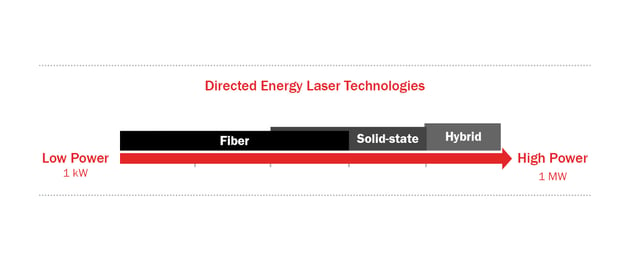While the use of lasers for directed energy (DE) increases, diversity in requirements and technology continues to evolve. Current directed energy applications, such as those used to eliminate airborne drones, range from comparatively lower-powered, man-portable lasers of 10 kW of optical output power to extremely high-powered lasers with 1,000 kW power levels. These 1 MW lasers are designed to be mounted on high-altitude platforms to destroy boost phase intercontinental ballistic missiles, among other missions.
To meet these expectations, the defense industry is currently developing and fielding multiple laser technologies, each offering their own unique strengths and weakness.
Three core technologies include:
- Fiber lasers. While typically used in the commercial material processing industry, this laser technology dominates the lower end of the power scale offering 1kW to tens of kilowatts of power. However, the size and weight requirements make industrially engineered fiber lasers challenging to integrate into defense platforms.
- Solid-state lasers. This could include slab and disk lasers which are currently used in battlefield targeting applications. The power level of solid-state laser technology offers a range of hundreds of kilowatts. DE lasers in the class of 100 kW to 1 MW are needed to pursue applications such as anti-cruise and ballistic missiles.
- Hybrid lasers. Diode-pumped alkali lasers are a prominent example of the new hybrid technology, which includes elements of both fiber and solid-state laser technologies. Hybrid technology strives to achieve megawatt power levels at size and weight targets compatible with airborne platforms.

All three types of directed energy laser technologies — fiber, solid-state or hybrid, have one thing in common —they are all optically pumped with a laser diode. Laser diodes offer an electrical-to-optical conversion efficiency over 60% and are easily scalable to MWs of power. This is an essential element for directed energy applications, as the increased power is needed to reduce the time the laser needs to be held on target and allows for effective targeting at an increased range.
To evolve technology in the directed energy industrial base, higher powers and smaller lasers are essential, making the size, weight, and power, collectively known as SWaP, major points of emphasis in the next generation of laser developments. SWaP disruptive laser technologies are paramount to making these weapons useful to the warfighter.


